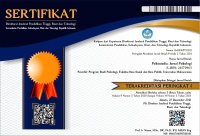Can Teenagers Put Their ‘Shoes’ On Prepetrators and Victims of Bullying?
Abstract
Social perspective taking (SPT) skills are needed to be able to understand that others have different thoughts than ourselves. This ability is one of the cohesive factors of bullying behavior. This study aims to find out the picture of the ability of early adolescent returns in perpetrators and victims of bullying. Conducted using a qualitative approach to explore adolescents' ability to understand other perception, the study involved subjects of 6 adolescents (3 boys and 3 girls) aged between 13 and 15 years. Data collection is done with open questionnaires and interviews based on the instrument The Social Perspective Taking Acts Measure (SPTAM). The object of the study is three themes, namely, the ability to identify the characteristics of the perpetrator and victim (acknowledgement), the thoughts and feelings of the perpetrator and victim (articulation) and the actions of the perpetrator and victim (positioning). The results showed that each participant was able to acknowledgement and positioning and had difficulty articulation. Articulation, which is the ability to identify the thoughts and feelings of perpetrators and victims, involves higher order thinking, which in the adolescent age range is still in the process of development. Thus, it seems that this is an aspect that needs to be improved with external (adult) help in order to be formed so that minimal prerequisites are met to prevent adolescents from engaging in bullying activities.
Kemampuan social perspective taking (SPT) diperlukan untuk dapat memahami bahwa orang lain memiliki pemikiran yang berbeda dari diri kita. Kemampuan tersebut merupakan salah satu faktor korelat dari perilaku perundungan. Penelitian ini bertujuan untuk mengetahui gambaran kemampuan SPT remaja awal pada pelaku dan korban perundungan. Dilakukan dengan memanfaatkan pendekatan kualitatif untuk mengeksplorasi kemampuan remaja dalam memahami sudut pandang orang lain, penelitian ini melibatkan subyek yaitu 6 remaja (3 laki-laki dan 3 perempuan) berusia antara 13 dan 15 tahun. Pengumpulan data dilakukan dengan kuisioner terbuka dan wawancara berdasarkan instrumen The Social Perspective Taking Acts Measure (SPTAM). Obyek studinya adalah tiga tema yaitu, kemampuan mengidentifikasi karakteristik pelaku dan korban (acknowledgement), pemikiran dan perasaan pelaku dan korban (articulation) serta tindakan pelaku dan korban (positioning). Hasil penelitian menunjukkan bahwa masing-masing partisipan mampu melakukan acknowledgement dan positioning dan mengalami kesulitan melakukan articulation. Articulation, yaitu kemampuan mengidentifikasi pikiran dan perasaan pelaku dan korban, secara melibatkan higher order thinking, yang di kisaran usia remaja masih berada dalam proses perkembangan. Dengan demikian, maka tampaknya ini adalah aspek yang perlu ditingkatkan dengan bantuan eksternal (orang dewasa) agar terbentuk sehingga terpenuhi prasyarat minimal yang diperlukan untuk mencegah remaja dari terlibat dalam kegiatan perundungan
Keywords
Full Text:
FULL TEXTReferences
Ainiyah, H. R., & Cahyanti, I. Y. (2020). Efektivitas Pelatihan Asertif Sebagai Upaya Mengatasi Perilaku “Bullying” di SMPN A Surabaya. Psikostudia : Jurnal Psikologi, 9(2), 105. https://doi.org/10.30872/psikostudia.v9i2.3868
Avşar, F., & Ayaz Alkaya, S. (2017). The effectiveness of assertiveness training for school-aged children on bullying and assertiveness level. Journal of Pediatric Nursing, 36, 186–190. https://doi.org/10.1016/j.pedn.2017.06.020
Ayu, N. P., Agustiani, H., & Novianti, L. E. (2017). Adaptasi Alat Ukur Perspective Taking Pada Remaja. Journal of Psychological Science and Profession, 1(3). https://doi.org/10.24198/jpsp.v1i3.15229
Barlinska, J., Szuster, A., & Winiewski, M. (2018). Cyberbullying among adolescent bystanders: Role of affective versus cognitive empathy in increasing prosocial cyberbystander behavior. Frontiers in Psychology, 9(MAY), 1–13. https://doi.org/10.3389/fpsyg.2018.00799
Batubara, J. R. (2016). Adolescent Development (Perkembangan Remaja). Sari Pediatri, 12(1), 21. https://doi.org/10.14238/sp12.1.2010.21-9
Branje, S. (2018). Development of Parent–Adolescent Relationships: Conflict Interactions as a Mechanism of Change. Child Development Perspectives, 12(3), 171–176. https://doi.org/10.1111/cdep.12278
Creswell, J. W. (2014). Research Design : Quanlitative, Quantitative and Mixed Nethods Approaches - Fourth Edition.
Diazgranados, S., Selman, R. L., & Dionne, M. (2016). Acts of Social Perspective Taking: A Functional Construct and the Validation of a Performance Measure for Early Adolescents. Social Development, 25(3), 572–601. https://doi.org/10.1111/sode.12157
Dugan, J. P., Bohle, C. W., Woelker, L. R., & Cooney, M. A. (2014). The role of social perspective-taking in developing students’ leadership capacities. Journal of Student Affairs Research and Practice, 51(1), 1–15. https://doi.org/10.1515/jsarp-2014-0001
Halimah, A., Khumas, A., & Zainuddin, K. (2015). Persepsi pada Bystander terhadap Intensitas Bullying pada Siswa SMP. 42(2), 129–140. https://doi.org/10.22146/jpsi.7168
Hardhiyanti, R. S., Pandjaitan, L. N., & Arya, L. (2020). Efektivitas Social Skills Training (SST) untuk Mereduksi Intensitas Bullying Pada Remaja. Psikostudia : Jurnal Psikologi, 9(1), 1. https://doi.org/10.30872/psikostudia.v9i1.3586
Hellström, L., & Lundberg, A. (2020). Understanding bullying from young people’s perspectives: An exploratory study. Educational Research, 62(4), 414–433. https://doi.org/10.1080/00131881.2020.1821388
Howitt, D. (2019). Introduction to Qualitative Research Methods in Psychology Putting theory into practice.
Jenkins, L. N. (2020). Bystanders in bullying: Introduction to the special issue. Journal of School Psychology, 81(August), 47–50. https://doi.org/10.1016/j.jsp.2020.07.002
John, A., Glendenning, A. C., Marchant, A., Montgomery, P., Stewart, A., Wood, S., Lloyd, K., & Hawton, K. (2018). Self-harm, suicidal behaviours, and cyberbullying in children and young people: systematic review. Journal of Medical Internet Research, 20(4). https://doi.org/10.2196/jmir.9044
Kim, H. Y., LaRusso, M. D., Hsin, L. B., Harbaugh, A. G., Selman, R. L., & Snow, C. E. (2018). Social perspective-taking performance: Construct, measurement, and relations with academic performance and engagement. Journal of Applied Developmental Psychology, 57(April), 24–41. https://doi.org/10.1016/j.appdev.2018.05.005
Krisnana, I., Rachmawati, P. D., Arief, Y. S., Kurnia, I. D., Nastiti, A. A., Safitri, I. F. N., & Putri, A. T. K. (2019). Adolescent characteristics and parenting style as the determinant factors of bullying in Indonesia: A cross-sectional study. International Journal of Adolescent Medicine and Health, 1–9. https://doi.org/10.1515/ijamh-2019-0019
Menesini, E., & Salmivalli, C. (2017). Bullying in schools: the state of knowledge and effective interventions. Psychology, Health and Medicine, 22, 240–253. https://doi.org/10.1080/13548506.2017.1279740
Nowell, L. S., Norris, J. M., White, D. E., & Moules, N. J. (2017). Thematic Analysis: Striving to Meet the Trustworthiness Criteria. International Journal of Qualitative Methods, 16(1), 1–13. https://doi.org/10.1177/1609406917733847
Pozzoli, T., Gini, G., & Thornberg, R. (2017). Getting angry matters: Going beyond perspective taking and empathic concern to understand bystanders’ behavior in bullying. Journal of Adolescence, 61(September), 87–95. https://doi.org/10.1016/j.adolescence.2017.09.011
Saarento, S., & Salmivalli, C. (2015). The Role of Classroom Peer Ecology and Bystanders’ Responses in Bullying. Child Development Perspectives, 9(4), 201–205. https://doi.org/10.1111/cdep.12140
Santrock, J. W. (2019). Child Development- Thirteenth Edition (13th ed., Vol. 148). McGraw-Hill.
Tamnes, C. K., Overbye, K., Ferschmann, L., Fjell, A. M., & Walhovd, K. B. (2018). Supplemental Material for Social Perspective Taking Is Associated With Self-Reported Prosocial Behavior and Regional Cortical Thickness Across Adolescence. Developmental Psychology, 54(9), 1745–1757. https://doi.org/10.1037/dev0000541.supp
Thomas, H. J., Scott, J. G., Coates, J. M., & Connor, J. P. (2019). Development and validation of the bullying and cyberbullying scale for adolescents: a multi-dimensional measurement model. British Journal of Educational Psychology, 89(1), 75–94. https://doi.org/10.1111/bjep.12223
Zakiyah, E. Z., Humaedi, S., & Santoso, M. B. (2017). Faktor yang Mempengaruhi Remaja dalam Melakukan Bullying. Prosiding Penelitian Dan Pengabdian Kepada Masyarakat, 4(2), 324–330. https://doi.org/10.24198/jppm.v4i2.14352
DOI: http://dx.doi.org/10.30872/psikostudia.v11i2.7321
Refbacks
- There are currently no refbacks.
Copyright (c) 2022 Psikostudia : Jurnal Psikologi

This work is licensed under a Creative Commons Attribution-ShareAlike 4.0 International License.
Indexing by :
_________________________________________
PSIKOSTUDIA: Jurnal Psikologi Published by Faculty of Social and Political Siences, University of Mulawarman, Samarinda, East Kalimantan and This work is licensed under a Creative Commons Attribution-ShareAlike 4.0 International License.
_________________________________________
PSIKOSTUDIA: Jurnal Psikologi
Department of Psychology
Faculty of Social and Political Siences, University of Mulawarman
Jl. Muara Muntai Kampus Gn. Kelua Samarinda 75411
Phone: +62 813 35350368
E-Mail: psikostudia@fisip.unmul.ac.id




















